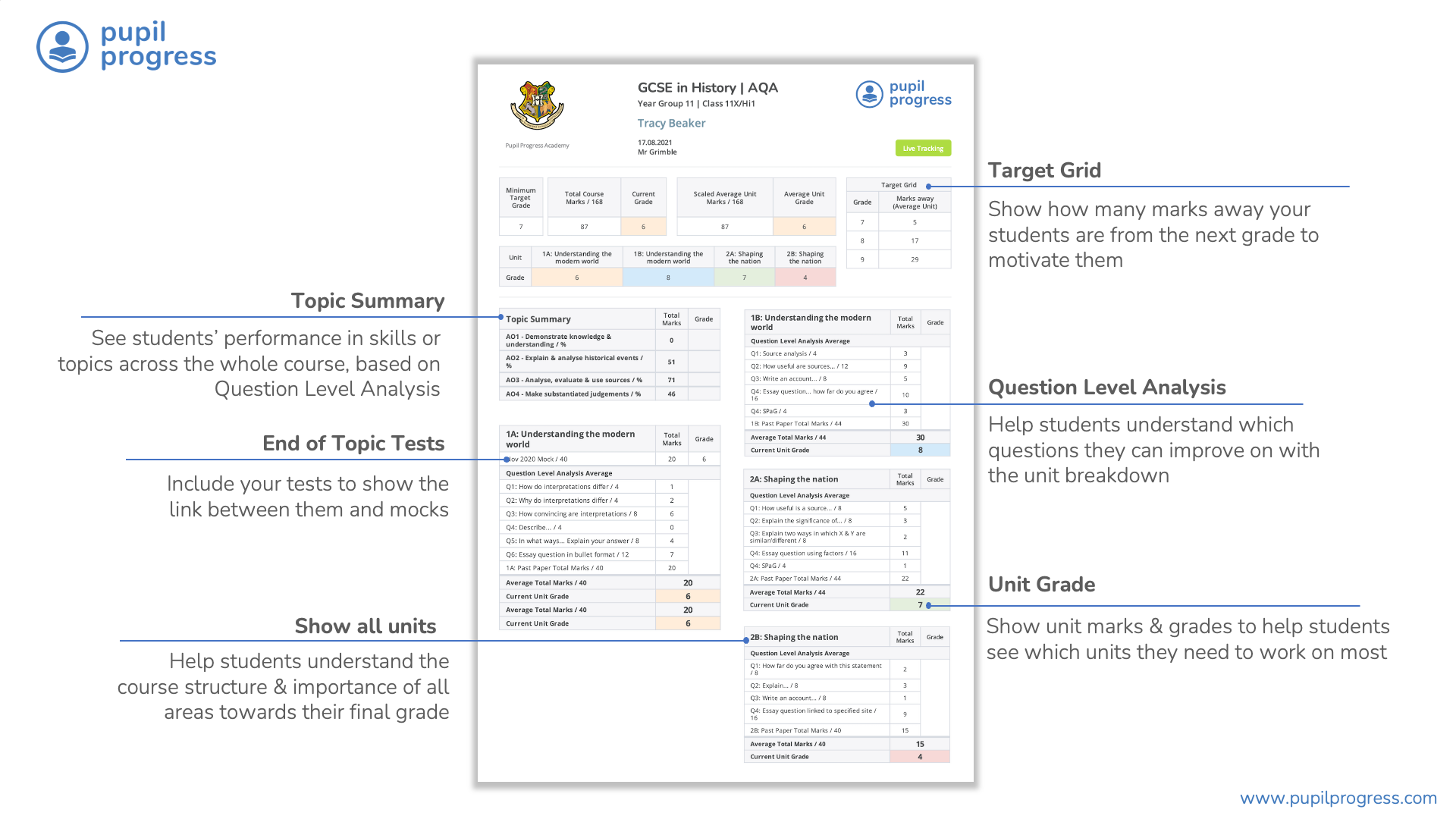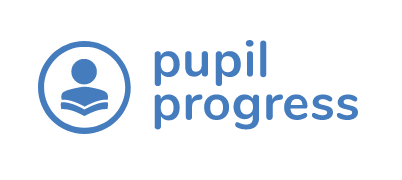Forget ‘meaningful data’: Think about your teachers & students

One of the drivers that led me to leave the teaching profession and start Pupil Progress was that I could see the impact an effective tracking and monitoring system would have on my students’ outcomes and my ability to support teachers in my team and do my job as a Head of Faculty.
Data is powerful, but only if it’s used effectively to empower and inform teachers in their decision-making and to help us make better choices as leaders. Distributing the leadership of a course by giving teachers ownership of certain aspects also maximises the pupils’ chances of success, relieves pressure, and improves efficiency and impact.
Get the data into your pupils’ hands
You can be very clever with data: finding trends and patterns that identify common themes, groups of pupils that are best to work with, topic areas to focus on within subsections… the list is endless.
All of this is very important, and can be extremely useful, but it’s almost useless if you haven’t got the buy-in from the students you’re teaching. One of my greatest frustrations when teaching was the feeling that pupils didn’t seem to understand or respect that their grades are theirs and not mine. I’m sure you and your teachers have been there yourselves.
Then I started to understand why this was. After all, why would pupils feel that it was their qualification and grade? Marks were recorded on my clipboard, copied into my spreadsheet, on my computer, then taken back to my office. I would then, at some point, try to find the time to call out the grade a pupil was working at for them to write in a small box in the corner of their folder or exercise book. It’s no wonder they felt disconnected from their qualifications and grades.
It was only when I started to provide my pupils with an individual report, one that broke down the course in its entirety, that I saw a huge shift in their mindset and motivation. The report detailed the marks and grade achieved per component, the total overall marks achieved, and the final grade. All of these were then assigned a colour via the traffic light system against their MTG (Minimum Target Grade).
These reports also detailed the number of marks students were away from each grade and their target grade. The reports were printed with their names on and added to their folders with the full detail of their current position, presenting their personal grades.
Understanding how data impacts performance
This was the most powerful action that I took, and it had the biggest impact on performance. Think about the psychology of knowing your exact position and what needs to be done to move forward. We need to know this as adults, it’s vital for our motivation, so why should this be any different for our pupils?
What I started to see in the lesson was remarkable: students began challenging their marks. Now, you may read this and think: “This is exactly why I don’t share grades.” Initially I did too, but when pupils became obsessed with the mark scheme or grading criteria, they became much more focused on the knowledge or skill that was required to move their grade forward. The impact here is twofold. Firstly, it challenges whether you as a teacher are making a judgement on the pupil’s personality, effort levels and/or behaviour, or their ability. Secondly, it shows the pupils that you haven’t just dreamt up a mark based on how much you like them or not: there is an actual, rigorous process that needs to be followed to meet the standards of the exam board.
Lastly, I noticed there was an understanding that I – the teacher of the course – really knew exactly what I was doing. It seemed to increase the level of trust in me from the pupils, and their confidence in my ability to lead them to the outcome that they wanted. This had a dramatic impact on their buy-in and reduced their resistance when making decisions on what needed to be delivered.
There is a very good reason why Ofsted will commonly ask open-ended questions to students, like:
- What are you doing in lesson today?
- Why are you doing this?
- What qualification are you taking?
This is to see if pupils actually know why they’re learning what they’re learning. As an adult, can you think of anything more frustrating than not knowing why it is you’re doing what you’re doing? Would you care? Would you pay attention? Whereas if you had a clear understanding of what you’re doing in a lesson and how it impacted your final outcome, how much more motivated would you be?
Get the data into your teachers’ hands
As a Head of Faculty, I was a big believer in making sure the teachers delivering the course not only knew the overall picture but also had full access to the nitty gritty. After all, the devil’s in the details.
Take the time to explain the course make up, how it all works, all the calculations, and why some parts of the course are calculated in certain ways. When a teacher understands all this vital information, there’s a greater level of confidence in the classroom, which improves their ability to plan strategically.
Allowing, or even encouraging, teachers to blindly follow a scheme of work (Lesson 1 teach this… Lesson 6 teach this…etc.) can be a recipe for disaster. The data might be telling you that a particular topic area has not been learned well and needs revisiting, or that some pupils will benefit from more time spent on something specific.
To give you an example in context, there are some courses which have a 60% theory weighting in comparison to the practical component – so we need to spend most of our time preparing for the exam, right? To challenge this, what if the pupil’s strength is practical and overall minimum target grade is 5. A grade 7 or 8 in the practical and 3 or 4 in the theory component will equate to a final grade of 5. Would you still spend all your time trying to secure a good grade in the theory because it has the highest weighting? Or would you actually spend more time trying to secure that 8 in the practical and then teach enough content, really well, to secure that 3 or 4 in the exam?
When teachers are able to understand and interpret the data, they are able to make smart, strategic decisions when it comes to lesson planning and delivery. Open that dialogue, challenge the lesson delivery status quo, allow teachers to challenge what’s best for the pupils in their class. Now, be prepared, this may mean that one teacher might be teaching different content at a different point in the year to another teacher teaching the same course. This is OK, so long as the delivery is completely tailored to the needs of the pupils in that class.
Get the data into the parents’ hands
Having been through more parents evenings than I care to remember, the exact moment that you lose the parents is the moment you utter the words: “OK, so, this is how the course is broken down”… Cue glazed eyes and nods. Nods that often weren’t even in time with the points I was trying to make.
Let’s be honest, everyone has had a long day: teachers, parents, and especially the pupils. How is anyone supposed to digest important information about a student’s performance by looking at an awkwardly turned computer screen, or printed Excel spreadsheet? That, coupled with a grade written in the corner of a school report, with no explanation or focus area, unsurprisingly leaves parents feeling confused and uninspired.
An individual report is a great way to present student data to parents. This allows parents to easily digest all key information, it helps them see and understand the makeup of the course, and how the mark from each component impacts on the final grade. It also clearly and easily shows areas of weakness, and therefore the areas of focus moving forward. This gets the parents on your side and everyone working towards the same goal.

Once again, there was trust. Parents felt that a teacher this organised, with this much information about their child and their progress, neatly displayed in a single handout, must be good at their job. As a result, the focus of the conversation was not to question the course delivery or how I was controlling the class, but instead focused on the key areas that obviously required attention. I found, in a lot of cases, that parents ended up leading the discussions: “So there was an intervention session focusing on the area that you are weakest at, and you didn’t go? You will be there next week, right!?”
Parents were also far more relaxed and engaged with the conversation, as they had something they could take away and digest later. This meant there was less pressure to try and understand the whole picture right away. I found some parents would even call back a few days after parents’ evening to ask questions on things they didn’t quite understand.
In summary… I cannot recommend highly enough the importance of sharing pupil’s data with all key stakeholders. There are many ways to use data effectively, particularly when looking at patterns and trends, but the impact is much greater when you have buy-in from everyone who’s responsible for achieving good grades in the qualification you’re delivering.
Individual reports are one of the many features we provide at Pupil Progress. Check out our no-obligation 4 week free trial to see if Pupil Progress is right for you.

Brett Griffin
Founder and Chief Executive Officer

Comments